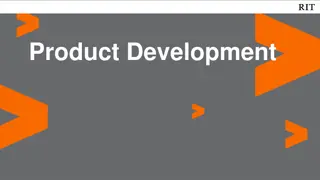Quality Management Principles for Successful Product Development
Understanding the importance of quality management in achieving successful product development, this article delves into the key concepts such as early quality control, defect prevention, and integration management. It emphasizes the need for proactive quality measures to avoid errors and ensure product reliability, with a focus on timely interventions and continuous improvement strategies.
Download Presentation

Please find below an Image/Link to download the presentation.
The content on the website is provided AS IS for your information and personal use only. It may not be sold, licensed, or shared on other websites without obtaining consent from the author. Download presentation by click this link. If you encounter any issues during the download, it is possible that the publisher has removed the file from their server.
E N D
Presentation Transcript
Right To keep in mind For Kan, this is part of Total Quality Management. Quality Management Models Kan Ch 9 Steve Chenoweth, RHIT 1
This is What Management Should Do Not the same as, How to accurately predict the quality of a product, which was the theme of Ch 7 and 8. Those were for Reliability estimation. Relied on having a full cycle of experimental data. In quality management, you want to intervene. Which of course spoils the experiment. 2
In particular A management model should Say what to do to control quality, early and often. Even so, we can use Rayleigh, exponential, etc. reliability models to see how things are going. Management just doesn t want to hear that we turned out a terrible product but got a great reliability experiment out of it! 3
Bottom line Get it right the first time pays off. Keep errors from being injected in. Don t wait to see how it goes during formal testing. Improving the front end quality is a big win. If product is beyond that, adding unit testing or pre-integration testing helps. 4
Rayleigh model Articulates points about early prevention. Myers principle The more defects found during formal testing, the more that remain to be found later ! Indicate that error injection rate is high. Iceberg size is the analogy. 5
Rayleigh, cntd Worst Best 6
Defect removal models assume Current experience follows past experience. No way to know if that s correct! Lower defect removal rates could mean: Lower error injection, or Poor reviews and inspections. 7
Use code integration pattern? Another way to manage quality. Look for what s not yet integrated! New code added here. 9
Integration management Late adders to integration are a red flag! Can test statistics vs prior products. What s pattern of integration? What s worst vs best ? Expected overall rate Could use lines of code 10
Use PTR arrival and backlog? PTR = Problem Tracking Report Can the code-freeze date be met without sacrificing quality ? Will the PTR arrival and backlog decrease to the predetermined desirable levels by the code freeze date? Use empirical models, based on prior data. 11
PTR concocted formulas Like Kan s on p 252: It includes a negative cubic term for Week and A squared term for KLOC . It was accurate within one week, for when arrivals would decrease to the predetermined desirable level prior to code-freeze. But Does anyone know why? 12
Backend reliability growth models Defects higher than expected caused a quality improvement program! 13
What did they do? Blitz testing made-up stress testing Customer evaluation More code inspections Design reviews Extension of system test more test suites 14
Do you have a good model? Kan re-emphasized his standards: Predictive validity Simplicity Quality of assumptions For management models, he suggests: Timeliness of quality indications Scope of coverage Capability to be the major criterion 15
To gather the data Need systematic reporting, like for: Defect tracking Metrics calculations Kan gives examples Right In our culture, in general, we are slowly but surely finding systematic ways to get a grip on complex processes. Here s one for combining results of many research studies to gain a meta-analysis that increases confidence in the overall meaning. 16
Inspections Hard to know if people are being objective! Need to know the small-team dynamics. I don t want to give Dave less than an 8! 17
Orthogonal defects Test different things Kan proposes these defect types: Function Interface Checking Assignment Timing/serialization Build/package/merge Documentation Algorithm 19
Rating defect attributes Activity Trigger Impact When fix is known: Target Defect type Defect qualifier Source Age 20
Recommendations for small orgs What leads to early defect removal? Rayleigh model proposed Front end use inspection scoring checklist Middle use code integration pattern Back end use a testing defect-related metric 21























